Six hundred million people, or one fifth of humanity at the time, watched Neil Armstrong’s first steps on the Moon in 1969. But seeing live transmissions from that historic event wouldn’t have been possible – and the Apollo missions wouldn’t have possible either – without reliable communications and accurate tracking capabilities.
To support the Apollo Program, NASA built the Manned Space Flight Network (MSFN) with three 85 foot (26 meter) antennas equally spaced around the world at Goldstone, California, Honeysuckle Creek, Australia and Fresnedillas (near Madrid), Spain.
Because of the movie “The Dish” however, most people think the Parkes Radio Antenna was the only dish used in Australia. But the Honeysuckle Creek dish was the real star of the Apollo missions. Most notably, it supplied voice and telemetry contact with the lunar and command modules but it also provided the first televised pictures of the Apollo 11 moonwalk.
“It was a job well done by many people all over the world,” said Bruce Ekert, a technician with the Honeysuckle Creek Tracking Station. “When I reflect that we were part of history, it is still amazing that it came together and worked so smoothly.”
The Honeysuckle Creek Tracking Station (HSK) was a radio-quiet location in the Australian Alps surrounded by granite peaks 32km southwest of Canberra, Australia’s capital.
Ekert helped install a microwave relay link from HSK to the Red Hill Radio Terminal in Canberra. “This link was the “missing link” as at that time, there was only a telephone line from HSK to Canberra, and this was unsuitable for TV pictures,” Ekert told Universe Today.
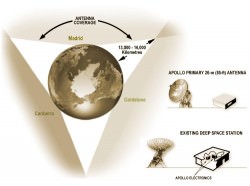
Ekert was working for the government telecommunications department and in April 1969 he was told his next job would be to install a microwave link so that when Australia’s side of the world was pointed toward the Moon, all the communications to the Moon and back could be relayed to NASA and mission control in Houston.
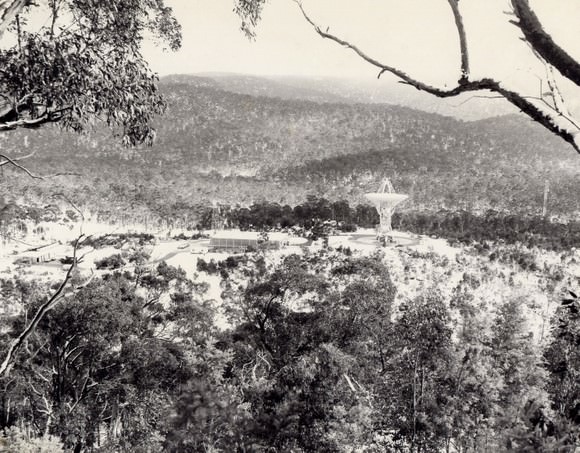
It may have been summer in the US, but in Australia it was winter. 1969 was cold and snowy, especially in snow country at 1200m (3600ft) up in the mountains, making the work difficult.
“It was cold and we had a lot of snow that year,” Ekert said, “Aligning microwave dishes on towers in cold weather, the bolts tend to lock up, and it’s difficult to move them around to get the best signal. Moving them with cold hands and cold steel is not the easiest things to do. But we installed microwave dishes on towers and equipment in the buildings. We also had to install a temporary tower with two dishes on it to redirect the signal through the mountains to get it out to the rest of the world.”
“We were running by the seat of our pants at one stage,” Ekert continued. “It was all thrown together and we knew it would work, but still, since we threw it together we hoped it would work according to plan.”
Ekert and his co-workers had to make sure the temporary links stayed working for the duration of the Apollo 11 mission.
“We maintained the equipment in a hands-off position,” he said. “As we say now, if it ain’t broke don’t fix it. We worked for the complete duration of the mission, but we weren’t allowed to touch anything if it was working – just let it run. If it had failed, then we would have had to fix it, but since everything just coasted along and there weren’t any problems, we just watched and waited like everyone else.”
But those at HSK had one little advantage. “The staff at Honeysuckle Creek actually were the first people in the world to see the pictures coming from the Moon, by a few milliseconds,” Ekert said. “So that is our claim to fame.”
Ed von Renouard, working at HSK was the first man in the world to see the pictures from the Moon as they came from the receiver in the dish. (See top image of Ed back in 1969, and below is Ed with Bruce Ekert)
But then after 8 minutes, NASA decided the larger 64meter Parkes Radio Telescope, 300 kilometers away, was getting a clearer signal and switched over for the remaining coverage of the spacewalk for the next two-and-a-half-hours.
Yes, there was a wind storm at Parkes, which threatened to blow the dish off course, as portrayed in “The Dish,” but Ekert said the movie was a typical Hollywood type creation.
“There were no crises where they were going to lose communications,” he said. “There was a big storm, where they had winds up to 60 mph (100 kph) at Parkes not long after the landing happened. They did fear the dish might be blown off course, but they always had the standby of Honeysuckle Creek, which was still receiving pictures, and at that point the moon had risen higher in the sky and pictures were actually better. So if the Parkes dish had actually been blown off course, they would have immediately switched back to Honeysuckle Creek.”
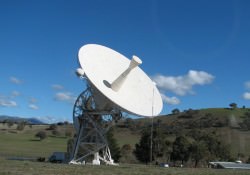
Parkes was part of MSFN’s “wing” stations to provide back-up and additional coverage. This meant that each of the three locations around the world would have two stations capable of communicating with Apollo spacecraft at lunar distances. In addition to just redundancy, there was another reason for having two Apollo-capable stations at each location. For project Apollo, communications used the higher frequency S-Band (around 2.2GHz), and the beam width of the 85 foot antennas at those frequencies was only 0.43 degree. Ideally, one antenna would track the Command Service Module in Lunar orbit and the other would track the Lunar Module to the surface.
Parkes was also called in to assist with the Apollo 13 emergency.
In addition, a number of other stations supported Apollo, including a facility at Tidbinbilla, 20 km away from HSK, which also had dedicated Apollo equipment and people to operate as an additional receive/transmit facility.
More permanent microwave relays were installed, and HSK was part of all the Apollo missions, and in 1974 at the conclusion of the Skylab program, HSK Creek joined the Deep Space Network as Deep Space Station 44, working deep space missions like Viking, Voyager, Pioneer and more. It was closed in December 1981, with its 26 meter antenna relocated to the Canberra Deep Space Communications Complex at Tidbinbilla, and renamed Deep Space Station 46, where it is still in use today.
The original HSK site has been leveled, and only the concrete foundations remain, but in 2001 an outdoor display was added. During Apollo 11 celebrations in July of this year, Ekert joined about 200 other people who worked at HSK, Parkes and Tidbinbilla to commemorate their achievements with Apollo.
“We traveled to the site of the HSK tracking station, for a ceremony unveiling a new plaque to show visitors and tourists where history was made on 21st July, 1969,” said Ekert. “We then moved over to another part of the site and a time capsule was filled with memorabilia from 1969 until now. My wife, who is Russian, put in a 50 Ruble note, with the words that there is not a “Cold War” anymore. The time capsule was buried, with instructions for the park rangers that it is to be dug up in 60 years time to mark the 100th anniversary of man’s first footsteps on the moon.”
Neil Armstrong also sent a note of congratulations for the ceremony, touching on the misconceptions the rest of the world might have because of things portrayed in the movie “The Dish.”
“Some of you, I expect, may have had mixed emotions about the film, THE DISH. I understand, because as technical people, we like things to be correct and accurate. And the film did not always accurately capture the roles of those of you at Honeysuckle Creek, those of you at Parkes, and those of you at Tidbinbilla. But for most of the viewers of the film around the world, those were not the details that they would remember anyway. What they will remember is that down in Australia there were some very dedicated people, with some very big antennae and complex electronic equipment that did remarkable things that were instrumental in the success of man’s first flights to the moon. They will have a sense that you were having a great time doing what you were doing. And what they remember will, in fact, be the truth.”
—from Neil Armstrong’s message to the Canberra Deep Space Communications Complex
Read all of Armstrong’s message here.
The celebrations continued in Australia in Canberra and at exactly 12.51pm local time, they showed a replay of the moon walk, with Neil Armstrong jumping down off the ladder of the lunar module to the surface of the Moon at exactly 12.56pm.
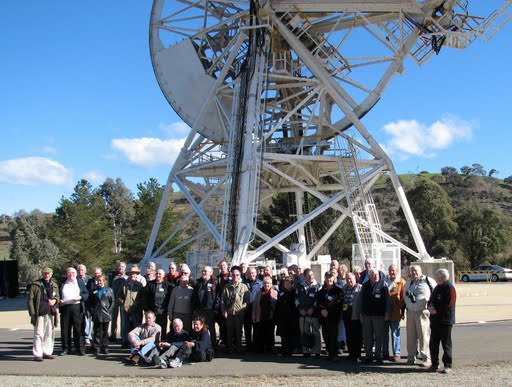
“The audio came over the auditorium sound system, and the atmosphere was awesome,” Ekert said. “It was a great celebration, where we patted ourselves on the back and had a salutatory drink to the whole situation.”
And a well deserved drink it was. The rest of the world sends its thanks to those who made watching television from the Moon possible.
Sources: Interview with Bruce Ekert, HoneysuckleCreek.net


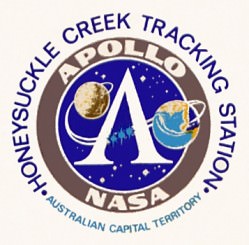
Great story, Nancy. I really enjoy these ‘footnote’ stories often left untold concerning these great moments in history.
HSK may have been the first to receive the TV transmission, but everyone seems to have forgotten Carnarvon Space Tracking Station which uplinked the signal to send Apollo 11 on its way to the moon.
It may not have had as big a dish as HSK but it was prime for the earth orbits and return of Apollo space craft.
It also played a major part in the Gemini missions, before HSK ws built.
I also remember that Brian Milne and I provided draft procedures etc to two HSK operations staff to help them establish their own.
Hi Nancy,
Thanks for that. I have just been involved with the Goonhilly Future World Apollo Celebrations. It was from S. Cornwall that Arthur the largest TV Dish in Cornwall att he time recieved and retransmitted those historic images to the BBC and then to the UK and all Europe.
The evening do was a public conference about the Moon and the return to it in the near future. It was a packed event… In aweful weather.
@ William928,
Actually, it’s a proofreading diploma that I have.
@ Brian Sheen,
Err… that should be: received, not “recieved”; awful, not “aweful”.
I am an equal opportunity critic. 😉
@ Nancy,
There is still the double “and” in paragraph 13, line 6. 😉
Err… I’ll get my coat and see myself out again…
I just read Neil Armstrong’s full message. What a genuinely classy guy he is.
Re IVAN3MAN
I had not had much sleep for several days, I proof read other work, but can easily miss my own typos.
Sorry – err … had you shut the door on your way out?
@ Brian Sheen,
What was that? I can’t hear you… the bloody door is shut!